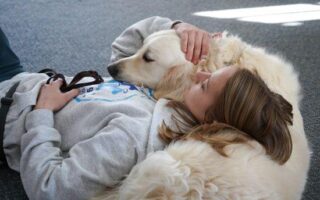As the gentle warmth of spring unfurls across the landscape, bringing vibrant blossoms and renewed vitality, so too does the spirit of adventure awaken in our four-legged companions. Among them, the lively and affectionate Springer Spaniel emerges as a beloved companion, known for their boundless energy and eagerness to please. However, as any devoted owner will attest, training a Springer Spaniel is not merely a task, but a rewarding journey that deepens the bond between human and pet. This article delves into the essentials of Springer Spaniel training, exploring effective techniques, common challenges, and the joys that come with shaping a well-mannered and happy pup. Whether you’re beginning your training odyssey or looking to refine your skills, join us as we outline the pathways to success in nurturing a well-behaved and spirited Springer Spaniel.
Table of Contents
- Understanding the Unique Temperament of Springer Spaniels
- Foundational Training Techniques for a Well-Behaved Companion
- Enhancing Socialization Skills Through Positive Experiences
- Overcoming Common Behavioral Challenges in Springer Spaniels
- Q&A
- Future Outlook
Understanding the Unique Temperament of Springer Spaniels
Springer Spaniels are known for their exuberant personalities, which can be both a blessing and a challenge during training. Their high energy levels mean they require constant engagement to keep them focused and content. These dogs are natural hunters, with a keen instinct to chase and explore, so training sessions should incorporate variety to cater to their curious nature. It’s crucial to establish a solid routine, using positive reinforcement techniques such as treats and praise, which resonates well with their affectionate temperament. Consistency and patience are key; offering rewards immediately when they exhibit desired behaviors will reinforce their learning.
Besides their playful disposition, Springer Spaniels are exceptionally intelligent and eager to please, making them highly trainable. They thrive on social interaction and often enjoy bonding experiences with their owners, which can be cleverly integrated into training. Incorporating fun, engaging activities not only enriches their minds but also strengthens the bond between dog and owner. Here are some fundamental aspects to consider when training:
- Positive Reinforcement: Always reward good behavior.
- Short Training Sessions: Keep sessions brief to maintain focus.
- Variety of Activities: Mix up training exercises to avoid monotony.
- Socialization: Introduce them to different environments and people.
Foundational Training Techniques for a Well-Behaved Companion
Establishing a solid foundation for training your Springer Spaniel is essential for cultivating a well-mannered companion. Consistency is key, so ensure that everyone in the household uses the same cues and commands. Start with basic commands such as “sit,” “stay,” and “come” to build a strong communication base. Reward your pup with praise and treats immediately following each successful command execution to reinforce positive behavior. Also, remember to maintain short, engaging training sessions to keep your dog eager and focused.
Incorporating fun games into the training routine can greatly enhance learning while keeping your Springer Spaniel enthusiastic. Activities like hide-and-seek or tug-of-war can make training enjoyable and reinforce the bond between you and your pup. Additionally, regular socialization with other dogs and people will help them develop good manners in various situations. Understanding the ideal training methods can also benefit both you and your pet. Consider the following techniques:
| Training Technique | Description |
|---|---|
| Positive Reinforcement | Rewards for desired behavior encourage repetition. |
| Clicker Training | A click sound marks correct behavior for clarity. |
| Leash Training | Teaches control and behavior during walks. |
| Impulse Control Games | Activities to strengthen patience and focus. |
Enhancing Socialization Skills Through Positive Experiences
One of the most enriching aspects of training a Springer Spaniel is the opportunity it provides for positive social interactions. These dogs thrive on companionship, and through structured training sessions, owners can encourage meaningful engagements, both with fellow dogs and people. Positive reinforcement techniques, such as treats, praise, and playtime, can create a supportive environment that makes learning socialization skills enjoyable for both the dog and the trainer. As training progresses, you can incorporate group activities such as:
- Playdates with other friendly dogs
- Training classes to meet new people
- Outdoor adventures to encounter various environments
Utilizing a combination of rewarding experiences and interactive environments fosters confidence in your Springer Spaniel. Treating each new experience as a chance to learn not only strengthens their social skills but also builds a stronger bond between you and your furry friend. Consider tracking your dog’s progress in a fun table format:
| Activity | Socialization Skills Developed | Notes |
|---|---|---|
| Playdate with a neighbor’s dog | Confidence, Playfulness | Watch for signs of comfort |
| Group training session | Focus, Obedience | Use commands in distraction |
| Visit a dog park | Adaptability, Interaction | Observe behavior with various dogs |
Overcoming Common Behavioral Challenges in Springer Spaniels
Springer Spaniels are known for their exuberant energy and friendly disposition, but they can also present unique behavioral challenges that require committed training strategies. Common issues such as excessive barking, jumping on people, and leash pulling can be managed effectively through consistent and positive reinforcement techniques. Creating a structured routine is essential, as it helps establish boundaries and expectations. Incorporate basic obedience commands like “sit,” “stay,” and “come” into your training sessions, and reward your dog with treats or praise to reinforce good behavior. Regular socialization with other dogs and people is also critical in reducing anxiety and promoting a calm demeanor.
In addressing specific problems, it can be beneficial to implement targeted training approaches. For instance, if your Springer tends to bark excessively, consider using techniques such as distraction or counter-conditioning, where you teach your dog to focus on a toy or command when they start barking. In cases of jumping, teaching the “off” command along with consistent cues when guests arrive can help mitigate the issue. To visually summarize these approaches, here’s a simple table outlining behaviors and potential solutions:
| Behavior | Training Solution |
|---|---|
| Excessive Barking | Distraction and Counter-conditioning |
| Jumping on People | Teach “off” command and use consistent cues |
| Leash Pulling | Practice “heel” and reward walking on a loose leash |
Q&A
Q&A: Springer Spaniel Training
Q1: What makes Springer Spaniels unique when it comes to training?
A1: Springer Spaniels are known for their intelligence and high energy levels, making them eager learners but also requiring a firm yet gentle approach. Their natural instinct as hunting dogs means they often crave outdoor activities and mental challenges, which trainers can harness to keep them engaged.
Q2: What are some essential commands that every Springer Spaniel should learn?
A2: Essential commands include “sit,” “stay,” “come,” “down,” and “leave it.” Starting with these foundational commands establishes good behavior and enhances safety, especially when outside or in distracting environments.
Q3: How can I keep my Springer Spaniel motivated during training sessions?
A3: Use positive reinforcement! Treats, praise, and playtime are great motivators for Springer Spaniels. Mixing up the rewards keeps the training fun and exciting. Additionally, incorporating activities they love—like retrieving or running—can make a significant difference in their enthusiasm.
Q4: What should I consider when developing a training schedule?
A4: Consistency is key. Short, frequent sessions (about 5-10 minutes) work best. Aim for two to three sessions per day, ensuring they fit your Springer Spaniel’s energy levels and attention span. A consistent schedule fosters good habits and keeps training manageable.
Q5: How do I address common behavioral issues in Springer Spaniels?
A5: Identifying the root cause is essential. Common issues like excessive barking, jumping, or chewing can stem from boredom or lack of exercise. Address these by increasing physical activity, providing interactive toys, or offering dedicated time for training and socialization.
Q6: Are there specific training techniques that work best for this breed?
A6: Techniques such as clicker training, which uses a sound to signal correct behavior, and agility training leverage their natural instincts and provide mental as well as physical stimulation. Building on their natural talents can improve focus and responsiveness during training.
Q7: How important is socialization in the training process?
A7: Socialization is crucial for Springer Spaniels. Early exposure to different environments, people, and other animals helps them develop into well-rounded dogs. Frequent and positive interactions can decrease anxiety and enhance their confidence in new situations.
Q8: What resources can I use to enhance my Springer Spaniel’s training?
A8: Consider enrolling in obedience classes or workshops which offer structure and professional guidance. Additionally, books, online courses, and instructional videos can provide useful insights and techniques. Make use of local parks or dog-friendly areas to practice skills in real-world settings.
Q9: When should I start training my Springer Spaniel?
A9: Training should start as early as possible; ideally, from 8 weeks old. Early exposure to basic commands and socialization experiences sets the tone for a lifetime of good behavior. However, it’s never too late to train, and older dogs can still learn new tricks!
Q10: What is the most important thing to remember about training a Springer Spaniel?
A10: Patience and consistency are paramount. Each dog learns at their own pace, and celebrating small successes can foster a positive training environment. With love, understanding, and dedication, your Springer Spaniel will thrive both in training and as a cherished member of your family.
Future Outlook
training your Springer Spaniel is a rewarding journey that deepens the bond between you and your furry companion. With consistent effort, patience, and a sprinkle of creativity, you can unlock the full potential of your dog’s natural instincts and intelligence. Remember, every wag of the tail and joyful leap is a testament to the trust and understanding developed through training. Whether you’re teaching basic commands or embarking on advanced agility courses, each step you take builds a foundation for a harmonious partnership. So grab those treats, channel your enthusiasm, and embrace the challenges and triumphs that come with training. Your Springer Spaniel is ready to learn—and together, you can make every lesson a memorable adventure. Happy training!


